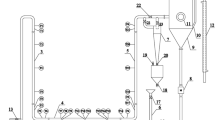Abstract
Particles in liquid-solid suspension flow might enhance or suppress the rate of heat transfer and turbulence depending on their size and concentration, The heat transfer characteristics of liquid-solid suspension in turbulent flow are not well understood due to the complexibility of interaction between solid particles and turbulence of the carrier fluid. In this study, the heat transfer coefficients of liquid-solid mixtures are investigated using a double pipe heat exchanger with suspension flows in the inner pipe. Experiments are carried out using spherical fly ash particles with mass median diameter ranging from 4 to 78 μm. The volume concentration of solids in the slurry ranged from 0 to 50% and Reynolds number ranged from 4,000 to 11,000. The heat transfer coefficient of liquid-solid suspension to water flow is found to increase with decreasing particle diameter. The heat transfer coefficient increases with particle volume concentration exhibiting the highest heat transfer enhancement at the 3% solid volume concentration and then gradually decreases. A correlation for heat transfer to liquid-solid flows in a horizontal pipe is presented.
Similar content being viewed by others
Abbreviations
- A :
-
Area,
- C p :
-
Specific heat, J/kg·°C
- C po :
-
Specific heat of hot oil, J/kg·°C
- C s :
-
Solid volume concentration, % or fraction
- d p :
-
Particle diameter, μm
- D :
-
Pipe diameter, m
- D h :
-
Hydraulic diameter of outer pipe, m
- h :
-
Convection heat transfer coefficient, W/m 2·°C
- h o :
-
Convection heat transfer coefficient of hot oil,W/m2·°C
- k :
-
Thermal conductivity, W/m·°C
- k o :
-
Thermal conductivity of hot oil, W/m.·°C
- k w :
-
Thermal conductivity of pipe, W/m·°C
- L :
-
Pipe length, m
- \(\dot m\) :
-
Mass flow rate, kg/sec
- \(\dot m_o \) :
-
Mass flow rate of hot oil, kg/sec
- q :
-
Heat transfer rate, W
- T :
-
Temperature,oC
- u :
-
Velocity, m/sec
- U :
-
Overall heat transfer coefficient, W/m2·oC
- ϱ:
-
Density, kg/m3
- μ:
-
Viscosity, N·sec/m2
- ΔP/ΔL :
-
Pressure drop per unit pipe length, Pa/m
- ΔT lm :
-
Log mean temperature difference, °C
- f :
-
Fluid
- i :
-
Inner side
- o :
-
Outer side
- p :
-
Particle
- s :
-
Slurry (liquid-solid mixture)w :Wall side
- Nu :
-
Nusselt numberhD/k
- Pr :
-
Prandtl number μC p /k
- Re :
-
Reynolds number ϱuD/μ
References
Gelperin, N. I. and Einstein, V. G., 1971, “Heat Transfer in Fluidized Beds.” InFluidization, des J. F. Davidson and D. Harrison, p. 471, Academic Press, London.
Haid, M., Martin, H. and Steinhagen, M., 1994, “Heat Transfer to Liquid-Solid Fluidized Beds,”Chemical Engineering & Processing, Vol. 33, pp. 211–225.
Harada, E., Toda, M. Kuriyama, M. and Konno, H., 1985, “Heat Transfer between Wall and Solid-Water Suspension Flow in Horizontal Pipes,”Journal of Chemical Engineering of Japan, Vol. 18, No. 1, pp. 33–38.
Hetsroni, G. and Rozenblit, R., 1994, “Heat Transfer to a Liquid-Solid Mixture in a Flume,”Int. J Multzphase Flow, Vol. 20, No. 4, pp. 671–689.
Incropera, F. P. and De Witt, D. P., 1996,Fundamentals of Heat and Mass Transfer, 3rd edition, John Wiley & Sons, Inc.
Kim, Byong Joo, 1998, “A Model for the Condensation Heat Transfer of Binary Refrigerant Mixtures,”KSME International Journal, Vol. 12, No. 2, pp. 282–290.
Landau, L. D. and Lifshitz, E. M., 1959, Fluid Mechanics, Addison-Wesley, p. 79.
Lee, S. L. and Borner, T., 1987, “Fluid Flow Structure in a Dilute Turbulent Two-Phase Suspension Flow in a Vertical Pipe,”Int. J. Multiphase Flow, Vol. 13, pp. 233–246.
Moon, Hee Jang, 1998, “Binominal Mixing Model for Premixed Reacting Turbulent Flows Applied to Autoignition,”KSME International Journal, Vol. 12, No. 2, pp. 320–329.
Ozbelge, T. A. and Somer, T. G., 1994, “A Heat Transfer Correlation for Liquid-Solid Flows in Horizontal Pipes,”The Chemical Engineering Journal, Vol. 55, pp. 39–44.
Popiel, C. 0. and Wojtkowiak, J., 1998, “Simple Formulas for Thermophysical Properties of Liquid Water for Heat Transfer Calculations (from 0°C to 150°C),”Heat Transfer Engineering, Vol. 19, No. 3, pp. 87–101.
Richardson, J. F., Romani, M. N. and Shakiri. K. J., 1976, “Heat Transfer from Immersed Surface in Liquid Fluidized Beds,”Chem. Eng. Sci. Vol. 31, pp. 619–624.
Salamone, J. S. and Newman, M., 1955, “Water Suspensions of Solids,”Industrial and Engineering Chemistry, Vol. 47, No. 2, pp. 283–288.
Zisselmar, R. and Molerus, 0., 1979, “Investigation of Solid-Liquid Pipe Flow with Regard to Turbulence Modification,”The Chemical Engineering Journal, 18, pp. 233–239.
Shires, G. L., 1994,Process Heat Transfer, CRC Press.
Author information
Authors and Affiliations
Corresponding author
Rights and permissions
About this article
Cite this article
Ku, JH., Cho, HH., Koo, JH. et al. Heat transfer characteristics of liquid-solid suspension flow in a horizontal pipe. KSME International Journal 14, 1159–1167 (2000). https://doi.org/10.1007/BF03185070
Received:
Revised:
Issue Date:
DOI: https://doi.org/10.1007/BF03185070




